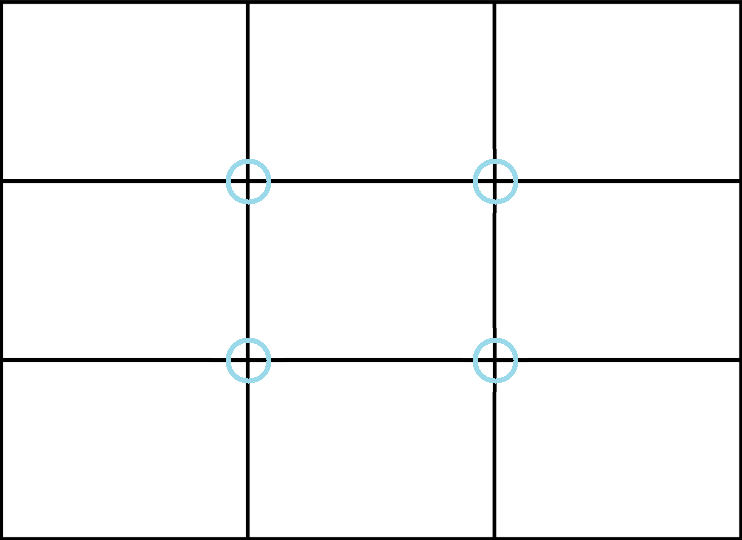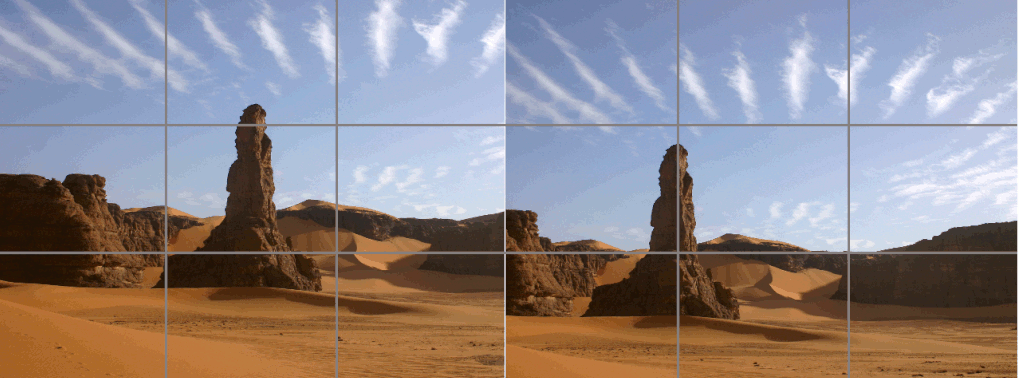Proportional Systems Cont.
The Rule of Thirds
The Rule of Thirds is a fundamental principle used in visual arts such as painting, photography, and design. This rule proposes that an image can be divided into nine equal parts by two equally spaced horizontal lines and two equally spaced vertical lines.
To apply the Rule of Thirds, draw two horizontal and two vertical lines, each at one-third intervals, across the image. This effectively splits the frame into nine evenly sized-rectangles. The essential parts of the image should be positioned either along these lines or at their intersecting points, which are indicated in blue.

The logic behind the Rule of Thirds is that placing points of interest along these lines or at their intersections creates more tension, energy, and interest in the composition than simply centering the subject would. This technique is used to encourage the viewer’s eyes to wander around the composition, creating a more interactive and engaging viewing experience.
In photography, for example, placing the horizon line on one of the horizontal grid lines rather than directly in the middle of the frame can create a more balanced and interesting photograph. Similarly, positioning the main subject of an image at an intersection of the grid lines can make the photograph more dynamic.

In design and architecture, the Rule of Thirds can guide the placement of elements within a space or layout to create a harmonious and balanced design.
The Rule of Thirds isn’t an absolute rule that must be followed, but it serves as a helpful guideline, especially for beginners. With more experience, artists and designers can learn when to use the rule and when it’s appropriate to break it for creative effect.
Utilizing the Golden Ratio and the Rule of Thirds in Analysis
Analyzing and assessing the composition of artworks, designs, and architectural structures using the golden ratio and the rule of thirds can provide insightful understanding of the aesthetic and structural decisions made by the creator.
When analyzing an artwork or design, you can start by overlaying a golden rectangle or a grid based on the rule of thirds on the piece. With the golden ratio, the placement of important elements of the design often align with the divisions created by the golden rectangle. For instance, you might find that the focal points of a painting align with the boundaries of the golden rectangles within the frame.
Similarly, you can use the rule of thirds to assess the composition of a photograph or a design. Divide the piece into nine equal sections by drawing two equally spaced horizontal lines and two equally spaced vertical lines. Look for the placement of important elements along these lines or at the points of intersection.
In architecture, both the golden ratio and the rule of thirds can be used to analyze the proportions of different elements of a structure. For example, the height and width of a building might adhere to the golden ratio, or the placement of windows and doors might follow the rule of thirds.
Using these tools not only provides a structured way to analyze and appreciate visual pieces, but it can also guide your own creations. By consciously incorporating the golden ratio and the rule of thirds in your work, you can achieve a sense of balance and harmony that is often pleasing to the eye.